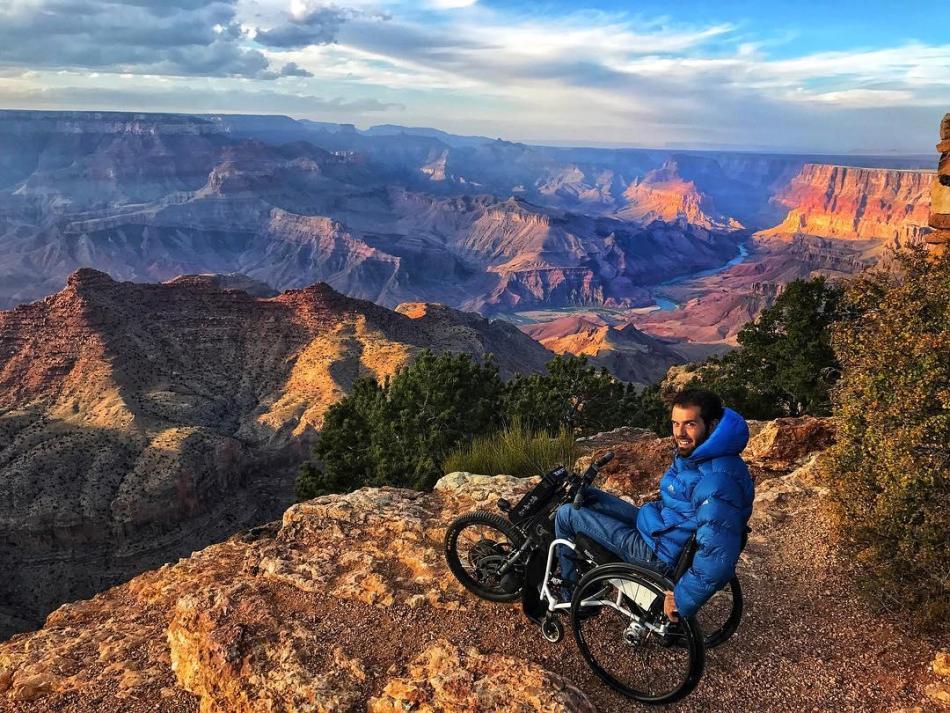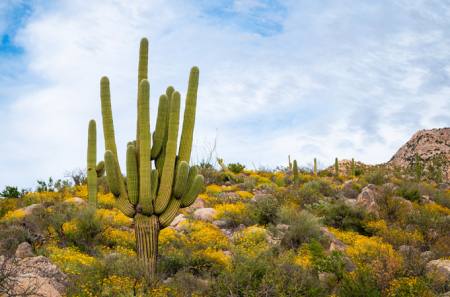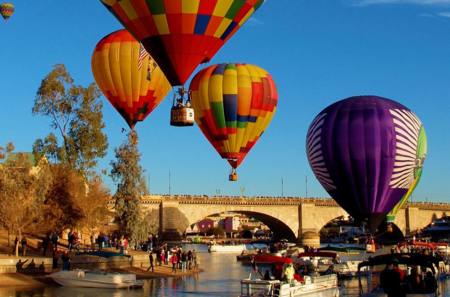13 Wheelchair-Accessible Trails in Arizona
Everyone—regardless of mobility—can enjoy Arizona's wild beauty. Here are 13 of the best accessible trails in the state.
Note: This is not an exhaustive list of accessible trails and places within Arizona (see Kartchner Caverns for another great example). We're simply showcasing a few of our favorite outdoor paths with diverse views.
Rim Trail
This 13-mile paved trail skirts the South Rim of the Grand Canyon from the South Kaibab Trailhead to Hermits Rest (see top image). On the way, the Rim Trail passes park highlights such as Mather Point, Hopi House and the historic hotel, El Tovar. Go as far as you want, then catch a free shuttle back to your starting point.
Crescent Moon Ranch

Credit: @he_wanders_off on Instagram
Two paved loops, totaling one mile, take visitors to Crescent Moon Ranch along Sedona's Oak Creek where the iconic Cathedral Rock can be seen reflected in the water. The historic ranch house that gives the site its name is a popular photo op; however, keep in mind crowds are especially heavy during the later afternoons and weekends. After working up an appetite, enjoy a picnic at one of the site's accessible tables.
Note: There is a day-use fee of $11 per vehicle (up to five people) or $2 per person for walk-ins and extra people, payable by cash or check at the entrance.
Dead Horse Ranch State Park
A mile and a half of accessible trails circle three lagoons at Dead Horse Ranch State Park in the Verde Valley, about 30 minutes west of Sedona. A canopy of cottonwood trees provides shade during the hotter days. Keen on spotting wildlife? The .25-mile Canopy Trail, which starts and ends at the River Day Use Area, is thick with birds and fauna. Finish your day in Old Town Cottonwood, which features a mix of vintage shops, restaurants, and tasting rooms with locally-made, award-winning wine.
Montezuma Castle National Monument

Montezuma Castle National Monument
Near the town of Camp Verde, Montezuma Castle National Monument attracts visitors eager to witness the impressive Sinagua cliff dwellings, viewable via the half-mile, paved Rimrock Trail. As an added bonus, your entrance fee to Montezuma Castle includes admission (valid for seven days) to Tuzigoot National Monument. There, both the visitor center and the Tavasci Marsh Overlook trail are fully accessible for wheelchairs.
Woodland Lake Park Trail
This paved, 1-mile trail rounds Woodland Reservoir in the Pinetop-Lakeside area. Although water levels can be low at times, the trail is popular, especially with local birdwatchers. Expect to see walkers, cyclists and even those on horseback enjoying the trail. The surrounding area, known as the White Mountains, is particularly nice during the spring, summer and fall months owing to the cooler temps, but expect snow and icy conditions during the winter.
Boyce Thompson Arboretum

Roses and solitude in the Wallace Desert Garden
The oldest botanical garden in the state features a mix of paved and compressed earth trails, including 1.5-miles of new walking trails, and loops through the recently-opened Wallace Desert Garden. Enjoy a well-laid cactus garden, in addition to a riparian area, an Australian forest, and herb and rose gardens. Guided trail tours are available for a nominal fee with advance registration. Located in the town of Superior, roughly 64 miles or an hour east of Phoenix.
Tempe Town Lake
Nearly 7.5 paved miles circle this urban lake near downtown Tempe and Arizona State University. Along the way, take a break at grassy parks, tour the public art, go fishing (with a proper permit, of course), or detour to the restaurants and boutiques on Mill Avenue. Just off the path is the Tempe Center for the Arts, which features live performances and a 3,500 square-foot gallery with rotating art exhibits.
Papago Park and Papago West Park
Several trails cut through Papago Park, which is home to the Phoenix Zoo and Desert Botanical Garden. While the Crosscut Canal Path and Galvin Bikeway Trail both run north-south nearly 1.5 miles, the much shorter Nature Trail travels a half-mile through the heart of the park. Expand your options by considering the trails in the zoo or botanical garden.
The Elliot Ramada Loop Trail, located across the street from Papago Park in Papago West Park, is a paved and dirt trail that loops 2.7 miles around red rock formations and buttes. Pause to appreciate the views of downtown Phoenix or to catch the sun setting over the city in the early evening.
Brown's Ranch
Part of the Scottsdale McDowell Sonoran Preserve, the Jane Rau Interpretive Trail at Brown's Ranch navigates nearly half a mile through the area and serves as a great introduction to the flora and fauna of the Sonoran Desert. Do note: The trail has sections of grading higher than what is average for an accessible trail as it was built to 2013 US Forest Service trail accessibility standards.
Riparian Preserve at Water Ranch
A mix of paved and flat dirt trails crisscross one of the state's best parks for urban birding in Gilbert, east of Phoenix. Start on the concrete trail around Water Ranch Lake, then branch off to the dirt trails circumventing the preserve's seven ponds. Signage around the trail helps educate visitors on the many plants and animals that have made the preserve their home. Additional amenities include benches, ramadas for shade, and an observatory.
Saguaro National Park

Credit: @r4clicks on Instagram
See thousands of the nation's largest cactus—the saguaro—on a .25-mile and .7-mile trail east of Tucson within Saguaro National Park's east section. The park's west section, situated on the other side of the city, has a half-mile paved trail as well.
Coronado National Forest
Located off I-10 in southern Arizona, this national forest has several short, accessible trails including the half-mile Sabino Canyon Nature Trail and the ⅓-mile Rose Canyon Lakeshore Trail. Both are in the Santa Catalina Mountains. If Sabino Canyon is on your list, consider booking a tour on one of the shuttles, which can hold up to two wheelchairs per trip and are available in English and Spanish.
Homolovi State Park
An hour east of Flagstaff, and about 10 minutes from the town of Winslow, the half-mile paved Homolovi II Trail leads to the largest of the park's archaeological sites. These Hopi pueblos contain nearly 2,000 rooms and date back to the 14th century.





